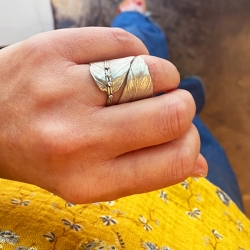TURQUOISE
The turquoise mines
Even though a lot of mines have closed in the US, there are still some in activity in Arizona, Nevada, New Mexico and Colorado.
One of the most famous mines for its turquoise is Sleeping Beauty, located in Globe, Arizona. Its turquoise is well known for its blue colour and its surface with no matrix. This mine was the biggest of the US until its closing in 2012. Its stones are still in use today.
The turquoise is one of the oldest and most popular stones. The first turquoises have been extracted 5000 years B.C in Egypt, Persia and Mexico. Venitian merchants introduced it for the first time in Europe in the 17th Century and they were convinced the stone came from Turkey, and that’s what gave the name « turquoise » to the stone.
In the 12th and 13th Centuries on the other side of the Earth, the Indigenous Americans extracted turquoises for the Aztec kings. With these stones they made pendants, pearls and business trades. Chinese sculpted the turquoises and made decorations of it in the 13th century. In Tibet, turquoise served as a currency. Even though there were some mines in China, most of the stones were coming from Persia, Tibet and Turkey. Among the Aztec and Persian peoples, turquoise was a symbol of wealth and distinction. A lot of peoples were considering turquoise as a sacred stone as well.
During the mid-19th Century, the Navajos, close to the Mexicans, were introduced to the methods of silver jewels production and started developing their own style. In the 1870s, the Navajos introduced the same thing to the Zunis, who developed the needle point style and the sun representation, called « sunface ».
The colour of the turquoise is mostly determined by the ground from which the stone is extracted – when the ground is full of copper, the stone is more blue whereas a ground full of iron gives a more green stone.
Nowadays, the turquoise remains a popular stone that we still see in a lot of ethnic jewellery collections.








